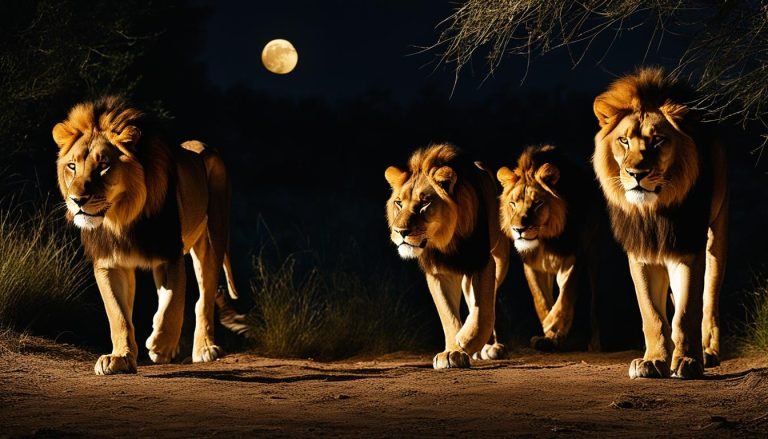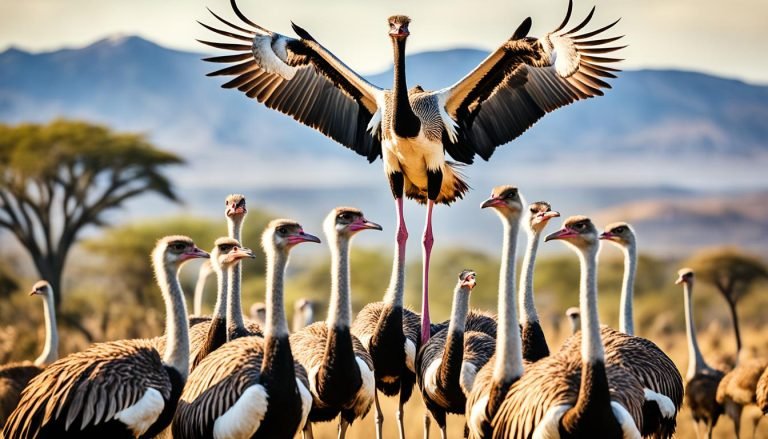Wild Horses’ Nocturnal Habits Unveiled
Do you ever wonder what wild horses do during the night? I remember a summer evening when I found myself camping near a vast meadow, surrounded by an untamed wilderness.
As darkness settled in, the air grew still, and the nocturnal symphony of nature began. It was then that I caught a glimpse of a small herd of wild horses, shimmering in the moonlight.
I watched in awe as these majestic creatures moved gracefully through the meadow, their hooves barely making a sound on the soft ground. It was a magical sight, and I couldn’t help but wonder what they were doing at this late hour. What were their nocturnal activities? How did their behavior change under the night sky?
In this article, we will delve into the fascinating world of wild horses and uncover the hidden secrets of the night. We will explore their unique behaviors, sleep patterns, and the factors that influence their nocturnal activities. So, join me as we embark on a journey to understand and celebrate the remarkable lives of these extraordinary creatures.

Key Takeaways:
- Wild horses exhibit intriguing behaviors during the night, which differs from their daytime activities.
- Understanding their nocturnal habits helps us appreciate their adaptability and survival mechanisms.
- Horses have unique sleep patterns and spend minimal time lying down to rest.
- Environmental factors and instincts influence their behavior at night.
- Creating a safe and comfortable environment for wild horses enhances their overall well-being.
Decoding Horse Sleep
Horses have unique sleep patterns that differ from humans. Understanding these patterns can provide valuable insights into their behavior and well-being. While horses require only a few hours of sleep per day, their sleep habits can vary.
One interesting aspect of horse sleep is known as “quiet standing.” During this sleep stage, horses remain standing but relax their muscles and lower their head slightly. This allows them to rest without fully lying down. It is a remarkable adaptation that enables them to stay alert and ready to flee if necessary.
Horses also can sleep both standing up and lying down. This flexibility allows them to transition between different sleep positions based on their comfort and safety.
Decoding horse sleep patterns is essential for horse owners and caretakers. By understanding how horses rest and rejuvenate, we can create an environment that promotes their well-being. Let’s dive deeper into the fascinating world of horse sleep habits.
Quiet Standing Sleep
Horses spend a significant portion of their sleep time in “quiet standing” mode. During this sleep stage, horses appear relaxed, with their head slightly lowered and their muscles at rest. It is an incredibly efficient way for horses to regain energy while remaining on their feet.
“Quiet standing sleep allows horses to sleep without leaving themselves vulnerable to predators.”
This sleep pattern also enables horses to engage in “power naps.” These short periods of deep rest provide horses with quick rejuvenation and can occur throughout the day and night.
Standing Sleep versus Lying Down Sleep
Horses have the remarkable ability to sleep both standing up and lying down. Unlike humans, their sleep duration is shorter, but they make up for it with brief, deep episodes of rest.
- Horses typically spend approximately 15 to 30 minutes lying down for deep sleep.
- During this time, their muscles fully relax and their body temperature drops.
- “Lying down sleep is crucial for horses to achieve the deepest levels of rest.”
However, horses primarily lean towards sleeping while standing because it allows them to remain alert and ready to react to any potential threats or disturbances. Their unique sleep habits have evolved as a survival mechanism in the wild.
Understanding horse sleep patterns and habits helps us better care for these magnificent animals. Through proper sleep management, we can ensure their overall well-being and provide them with the rest they need to thrive.
Why Horses Rarely Lie Down
Horses have evolved a fascinating ability to sleep while standing up, and this behavior is known as the “stay apparatus.” This survival mechanism in the wild allows horses to stay alert and ready to flee from potential predators at a moment’s notice. Unlike humans or many other animals, horses rarely lie down to sleep.
Lying down for extended periods can make horses vulnerable and hinder their ability to escape quickly. By sleeping while standing, horses can maintain a state of heightened awareness, ensuring their safety even while they rest.
Furthermore, the anatomy of a horse’s digestive system also contributes to their preference for standing sleep. Horses have a unique gastrointestinal structure that requires a constant flow of food through their digestive tract. Their continuous grazing helps prevent complications such as colic. By sleeping while standing, horses can easily transition from resting to eating, ensuring their dietary needs are met.
This sleeping habit is just one example of the remarkable survival mechanisms exhibited by horses, showcasing their adaptability and resilience in the wild.
The Fascinating Facts About Horse Sleep
When it comes to sleep, horses have some intriguing characteristics that set them apart from other animals. Here are some interesting facts about horse sleep:
- Horses sleep less than other animals and humans, typically only around three hours per day.
(interesting facts about horse sleep, horse sleep duration) - Horses have the remarkable ability to sleep both standing up and lying down, allowing them to adapt to their environment.
- Horse sleep is divided into short periods throughout the day and night, rather than one long continuous sleep cycle.
(horse sleep patterns)
Understanding these facts about horse sleep helps us appreciate the unique nature of these magnificent creatures. Let’s delve deeper into their fascinating sleep patterns and habits.
Horses sleep less than other animals and humans, usually around three hours per day.
“Understanding horse sleep facts helps us appreciate their unique nature.”
The Sleep Patterns of Horses
Horses have a distinctive sleep pattern that consists of alternating periods of deep sleep and light sleep. During deep sleep, horses may lie down or remain standing, while in lighter sleep stages, they often sleep while standing up.
Interestingly, horses exhibit a state of sleep called REM (rapid eye movement) sleep, similar to humans. During REM sleep, their eyes close, and they experience muscle relaxation, but their legs remain locked in position.
This unique sleep pattern allows horses to remain alert to potential threats while still getting the rest they need. It’s a fascinating adaptation that showcases their remarkable instincts and survival mechanisms.
Horse Sleep Patterns:
| Sleep Stage | Description |
|---|---|
| Deep Sleep | Horses may lie down or sleep while standing up. During this stage, they experience the most restorative sleep. |
| Light Sleep | Horses often sleep while standing up. They are still aware of their surroundings and can quickly respond to any potential danger. |
| REM Sleep | Horses experience REM sleep, characterized by closed eyes, muscle relaxation, and locked leg position. |
Understanding the sleep patterns of horses is essential for their overall well-being. Providing them with a comfortable and safe environment to rest ensures that they can maintain their optimal health and perform at their best.
The Sleep Patterns of Horses
Horses have unique sleep patterns consisting of both deep and light sleep stages. Understanding these patterns is crucial for horse owners and caretakers to provide optimal rest and care. One fascinating aspect of horse sleep is their ability to enter REM (rapid eye movement) sleep even while standing up.
REM sleep is a deep sleep stage characterized by closed eyes and relaxed muscles. During this stage, horses may exhibit twitching muscles and flickering eyelids, indicating potential dreaming. Despite being in a deep sleep, their legs remain locked in place, allowing them to maintain their upright position.
Let’s take a closer look at the sleep stages of horses:
- Wakefulness: Horses spend a significant portion of their day in a wakeful state, being alert and engaging in various activities.
- Quiet Standing: Horses enter a sleep stage called quiet standing, where they relax their muscles and lower their head slightly while remaining standing. This stage helps them conserve energy and rest without fully lying down.
- Light Sleep: Horses experience periods of light sleep throughout the day and night. This stage allows them to rest while remaining vigilant.
- Deep Sleep: Horses also have short periods of deep sleep, where they experience more profound rest. During deep sleep, they may lie down to fully relax their muscles and achieve a state of rejuvenation.
To better visualize the sleep stages of horses, below is a table summarizing their sleep patterns:
| Sleep Stage | Description |
|---|---|
| Wakefulness | Horses are alert and engaged in various activities. |
| Quiet Standing | Horses relax their muscles and lower their head slightly while remaining standing. |
| Light Sleep | Horses experience periods of light sleep throughout the day and night. |
| Deep Sleep | Horses have short periods of deep sleep, during which they may lie down to fully relax their muscles. |
Understanding the sleep patterns of horses is essential for their well-being. Providing a comfortable and safe environment that caters to their unique sleep needs can contribute to their overall health and happiness.
Equine REM Sleep
Horses, like humans and many other animals, experience REM sleep. REM stands for “rapid eye movement,” and it is a stage of sleep associated with dreaming and memory consolidation. During REM sleep, horses exhibit twitching muscles and flickering eyelids, indicating that they may indeed dream. This fascinating phenomenon suggests that horses have a rich internal world and experience vivid dreams, just like we do.
Equine REM sleep plays a crucial role in the overall well-being of horses. It allows for the processing and consolidation of memories, which is essential for learning and adaptation. Additionally, REM sleep helps regulate brain activity and emotional processes, contributing to the emotional and mental health of horses.
Understanding horse REM sleep is important for horse owners and caregivers. Providing an environment that promotes healthy sleep behavior can enhance the overall welfare of horses. From creating a comfortable sleeping area to managing stress levels, there are various ways to support horses in experiencing restorative REM sleep.
To ensure horses get the rest they need, it’s essential to establish a consistent sleep routine. Maintaining a regular schedule for feeding, exercise, and rest can help regulate horses’ sleep patterns and promote the ideal balance of sleep stages.
“Just like humans, horses can have dreams too. Equine REM sleep allows them to process memories and emotions, contributing to their overall well-being.”
The Role of Sleep in Horse Health
Sleep plays a vital role in the overall health of horses. While they rarely lie down to sleep, providing a safe and comfortable sleeping environment is essential for their well-being.
Horses rely on sleep to rest, rejuvenate, and maintain their optimal health. Just like humans, horses require adequate sleep to function properly and maintain their physical and mental well-being.
During sleep, horses have the opportunity to recover and repair their body tissues, regulate their metabolism, and consolidate their memories. It is a crucial time for their bodies to recharge and prepare for the activities of the following day.
Ensuring that horses have a conducive sleeping environment is important for their overall health. This includes providing a clean and well-ventilated space, ensuring a comfortable resting surface, and minimizing disturbances that may disrupt their sleep.
Additionally, understanding the specific sleep patterns and needs of horses can help horse owners and caretakers create an optimal routine. By aligning their schedule with natural horse sleep cycles, it is possible to support their sleep patterns and promote overall well-being.
Proper sleep is an essential component of horse care, and neglecting their sleep needs can have negative consequences on their health. By prioritizing their sleep and providing a conducive environment, horse owners can contribute to the overall well-being of their equine companions.
Important Points:
- Sleep is crucial for the health and well-being of horses
- Horses require a safe and comfortable sleeping environment to rest and rejuvenate
- Understanding horse sleep patterns can help optimize their care
- Neglecting their sleep needs can have negative effects on their overall health
| Benefits of Sleep for Horses | Consequences of Sleep Deprivation |
|---|---|
| Rest and rejuvenation of body tissues | Physical and mental fatigue |
| Regulation of metabolism | Reduced immune function |
| Memory consolidation and learning | Irritability and behavioral changes |
| Optimal physical and mental performance | Decreased focus and attention |
Horse Behavior at Night
Horses exhibit different behaviors at night compared to the day. The darkness and quietness of the night trigger specific activities and instincts in these majestic creatures. Let’s explore the fascinating horse nighttime behaviors.
Nighttime Rest and Activity
During the night, horses engage in restful activities, such as sleeping, grazing low-energy foods, and interacting with their companions. Their restful activities help them conserve energy and maintain the optimal balance for their bodies.
“The tranquility of the night provides horses with a peaceful environment for relaxation and rejuvenation. It’s during this time that their bodies can recharge and prepare for the day ahead.”
Keen Sense of Hearing
Horses possess a remarkable sense of hearing, which becomes even more heightened at night. Their ears swivel and turn, constantly scanning their surroundings for any potential threats. This acute sense of hearing helps them detect the slightest rustling in the darkness, ensuring their safety.
Alertness and Vigilance
Being prey animals, horses have evolved to be more alert at night. Their survival instincts kick in as they remain aware of their surroundings, ready to react swiftly to any potential danger. Their keen senses, particularly their vision and hearing, play a crucial role in keeping them safe during the nocturnal hours.
In conclusion, understanding horse behavior at night provides valuable insights into their instincts, needs, and preferences. By acknowledging and respecting their nighttime activities, we can create a harmonious environment that supports their overall well-being.
Horse Sensory Adaptations for Night Vision
Horses possess remarkable senses that have adapted to allow them to navigate and perceive their surroundings even in low-light conditions. One key adaptation that contributes to their ability to see at night is their impressive night vision.
These magnificent creatures have large, expressive eyes that grant them a wide field of vision, allowing them to take in a greater amount of visual information. This expansive field of view enables horses to detect potential dangers and obstacles with precision, aiding in their overall safety during nighttime activities.
In addition to their broad field of vision, horses have evolved specific adaptations that enhance their night vision capabilities. One of these adaptations is the presence of a higher number of rod cells in their eyes. Rod cells are photoreceptor cells responsible for vision in dim light. By having more rod cells, horses can effectively gather and process available light, improving their ability to see clearly in dark environments.
Another crucial adaptation found in horses is the tapetum lucidum, a reflective layer located behind the retina. The tapetum lucidum acts as a mirror, reflecting and enhancing any incoming ambient light. This reflection boosts the amount of light available to the retina, enhancing the horse’s visual perception and allowing them to distinguish objects with greater clarity under low-light conditions.
These sensory adaptations provide horses with a distinct advantage when navigating their environment at night. Whether it’s grazing in a dimly lit pasture or traversing unfamiliar terrain under the moonlight, horses can rely on their enhanced night vision to guide them safely through the darkness.
The Role of Circadian Rhythms in Horse Activity

Circadian rhythms play a significant role in regulating horse activity levels, preferences, and daily routines. Just like humans, horses have internal biological clocks that help regulate their sleep-wake cycles and physical behaviors. By understanding their circadian rhythms, we can better optimize their care and ensure their well-being.
Horses are naturally diurnal animals, meaning they are most active during daylight hours. However, it is important to note that horses still exhibit some activity during the night. Research has shown that horses tend to have a period of increased activity around dawn and dusk, known as the crepuscular period.
During these crepuscular periods, horses engage in various activities such as grazing, socializing with other horses, and exploring their surroundings. This behavior is thought to be influenced by their evolutionary history as prey animals, utilizing the twilight hours when many predators are less active.
Understanding horse circadian rhythms can help horse owners and caretakers establish consistent daily routines for their equine companions. Regular feeding times, exercise schedules, and turnout periods can be aligned with their natural activity patterns, promoting a sense of stability and well-being for the horses.
To further illustrate the influence of circadian rhythms on horse activity, here’s a breakdown of a typical daily routine for a horse:
| Time | Activity |
|---|---|
| Morning | Increased activity, grazing, socializing |
| Midday | Resting, napping, decreased activity |
| Afternoon | Moderate activity, exercise, grooming |
| Evening | Decreased activity, feeding, socializing |
| Night | Periods of rest, minimal activity |
By aligning their daily routines with their natural circadian rhythms, horse owners can help promote a sense of comfort, reduce stress, and maintain optimal health for their beloved equines.
Factors that Affect Horse Nighttime Activity
Several factors influence a horse’s nighttime activity, contributing to their behavior, preferences, and overall well-being. These aspects range from environmental conditions and social interactions to nutritional factors, health, and comfort.
Environmental conditions play a significant role in shaping a horse’s nighttime activity. Factors such as temperature, humidity, and lighting can impact their comfort and behavior. Horses may prefer specific areas that offer shelter, such as stalls or shaded spots, during the night to protect themselves from extreme weather conditions.
Social interactions also influence a horse’s nighttime activity. Horses are herd animals and form strong bonds with their fellow equines. Their behavior at night can be influenced by the presence or absence of other horses. They may engage in activities like mutual grooming, playing, or grazing together, fostering a sense of security and companionship.
Nutritional factors are crucial in determining a horse’s nighttime behavior. Horses have specific dietary needs and preferences. Access to food sources and the type of forage available can affect their grazing habits at night. Horses may selectively choose certain plants or grasses based on taste or nutritional value.
Health is another important factor impacting horse nighttime activity. Just as with humans, horses’ well-being can be influenced by factors such as injuries, illnesses, or chronic conditions. Pain or discomfort can alter their behavior, affecting their ability to rest or engage in normal activities at night.
Comfort is key to promoting healthy horse nighttime behavior. Factors such as bedding quality, stall size, and ventilation can significantly impact a horse’s restfulness during the night. Ensuring a comfortable sleeping environment plays an essential role in their overall well-being and quality of sleep.
Understanding the different factors that affect horse nighttime activity allows horse owners and caretakers to create an environment that promotes their well-being. By considering the horse’s individual needs, preferences, and the influence of their surroundings, we can help ensure that these magnificent creatures thrive during their nighttime hours.
Conclusion
Understanding horse behavior and their nighttime habits is crucial for providing proper care and ensuring their health and well-being. Horses have unique sleep patterns and preferences that require special attention during the night.
By recognizing that horses rarely lie down to sleep and spend a significant amount of time standing up, we can create a safe and comfortable environment for them to rest. This includes providing ample space for them to move around, as well as ensuring access to soft bedding and a quiet, dimly lit sleeping area.
In addition, considering their instincts and behaviors at night, such as their preference for low-energy grazing, helps us meet their nutritional needs. It is also important to be aware of their heightened sense of hearing and be mindful of any potential disturbances that may impact their sleep.
Overall, by gaining a deep understanding of horse behavior at night and considering their unique needs, we can create a nighttime routine and environment that promotes their health, happiness, and overall well-being.
More About Horses
- Equine Self-Defense: How Do Horses Defend Themselves?
- What Do Horses Need To Survive in The Wild?
- Do Horses Have Predators? Natural Equine Predators
- Do Horses Eat Humans? Myth or Reality
- Do Horses Hibernate in Winter? Equine Myths Debunked
- Do Horses Eat Other Horses? Equine Diet Explained
- Wild Horses’ Nocturnal Habits Unveiled
- Wild Horses Daily Routine Explained
- How Do Horses Communicate with Each Other?
- Where Do Wild Horses Sleep?
- Global Horse Population: How Many Horses Exist in the World
- Horses and Water: Can Horses Swim Naturally?
FAQ
What are some of the wild horses nocturnal habits?
Wild horses exhibit different behaviors at night compared to the day. They may engage in restful activities like sleeping or grazing low-energy foods. They have a keen sense of hearing and are more alert at night.
Why do horses sleep standing up?
Horses have evolved the ability to sleep while standing up as a survival mechanism. Lying down makes them vulnerable to predators, so sleeping while standing allows them to stay alert and flee quickly if needed.
What are some interesting facts about horse sleep?
Horses sleep less than other animals and humans, usually around three hours per day. They can enter a deep sleep state called REM (rapid eye movement) sleep while standing up. During REM sleep, their eyes close, and their muscles relax, but their legs remain locked in position.
What are the sleep patterns of horses?
Horses have a sleep pattern that consists of short periods of deep sleep and longer periods of light sleep. They sleep both standing up and lying down, with REM sleep occurring while standing.
What is equine REM sleep?
Equine REM sleep is a deep sleep state associated with dreaming and memory consolidation. Horses have twitching muscles and flickering eyelids during REM sleep, indicating that they may indeed dream. REM sleep is important for their overall well-being.
What is the role of sleep in horse health?
Sleep plays a vital role in the overall health of horses. While they rarely lie down to sleep, providing a safe and comfortable sleeping environment is essential. Sleep helps horses rest, rejuvenate, and maintain their optimal health.
How do horses behave at night?
Horses exhibit different behaviors at night compared to the day. They may engage in restful activities like sleeping or grazing low-energy foods. They have a keen sense of hearing and are more alert at night.
How do horses adapt for night vision?
Horses have large, expressive eyes that provide them with a wide field of vision. They also have enhanced night vision capabilities due to a higher number of rod cells and a reflective layer called the tapetum lucidum. These adaptations help them see in low-light conditions.
What is the role of circadian rhythms in horse activity?
Circadian rhythms influence horse activity levels, preferences, and routines. Horses are naturally diurnal but still exhibit some activity during the night. Understanding their circadian rhythms helps optimize their care and well-being.
What factors affect horse nighttime activity?
Environmental conditions, social interactions, nutritional factors, health, and comfort all influence a horse’s nighttime activity. These factors can affect a horse’s behavior, preferences, and overall well-being.
How can understanding horse nighttime habits help in their care?
Examining the nighttime habits and behavior of horses helps us provide proper care and promote their health and well-being. By understanding their unique sleep patterns and preferences, we can create a safe and comfortable environment for them at night.







